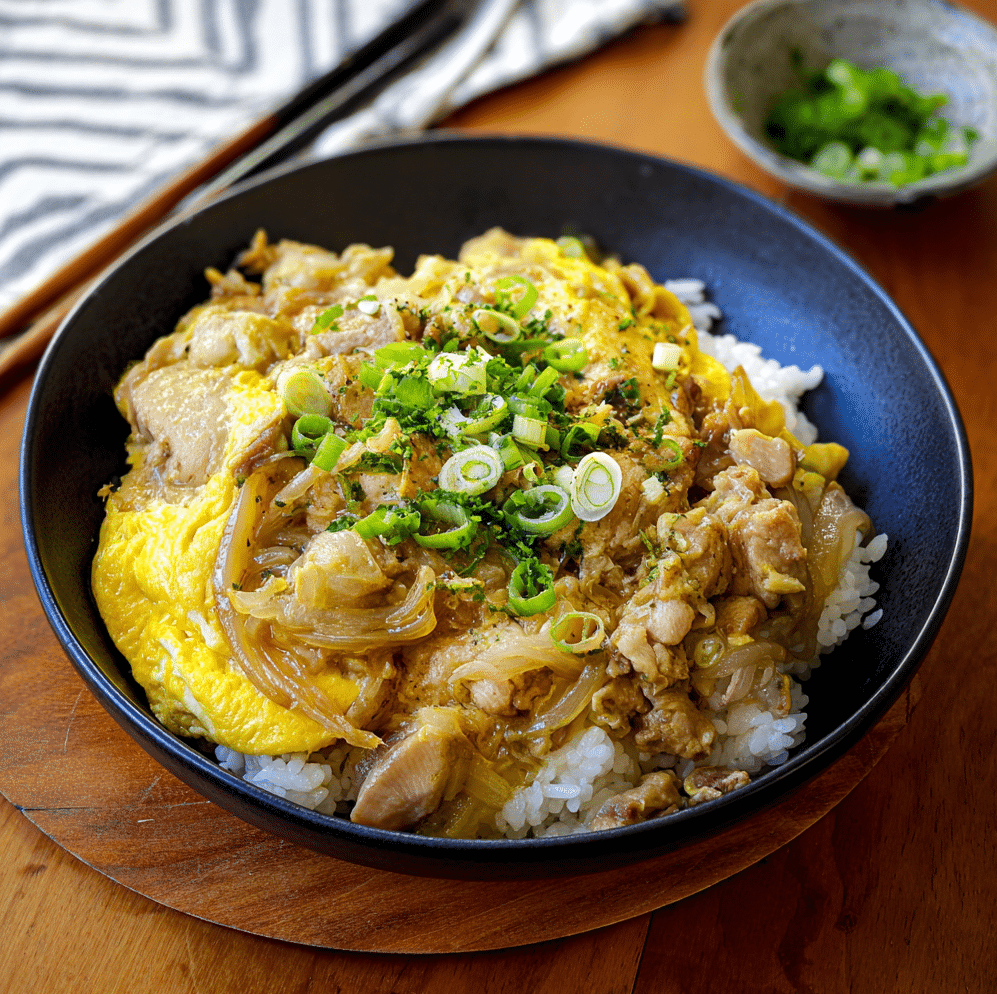The beauty of Oyakodon lies in its simplicity and soul-soothing flavor. This traditional Japanese rice bowl brings together tender chicken, silky egg, and savory dashi in perfect harmony, all served over a bowl of warm, fluffy rice. It’s the ultimate quick comfort meal that feels like a hug in a bowl.
Whether you’re craving something hearty, need a nourishing meal on a busy day, or want to explore Japanese home cooking, Oyakodon is an excellent place to start. It’s fast, flavorful, and deeply satisfying. Best of all, it’s made with pantry staples and ready in under 30 minutes. Add it to your weeknight rotation and enjoy the authentic taste of Japan at home.
Full Recipe
Ingredients:
-
2 boneless, skinless chicken thighs, cut into bite-size pieces
-
2 large eggs
-
1/2 onion, thinly sliced
-
1/2 cup dashi stock (or substitute with low-sodium chicken broth)
-
1 1/2 tbsp soy sauce
-
1 tbsp mirin
-
1 tbsp sake
-
1/2 tsp sugar
-
2 bowls cooked Japanese short-grain rice
-
Chopped green onions or mitsuba (Japanese parsley), for garnish
Directions:
-
In a small bowl, lightly beat the eggs and set aside.
-
In a medium skillet, combine dashi, soy sauce, mirin, sake, and sugar. Bring to a simmer over medium heat.
-
Add the sliced onion and simmer until soft, about 3–4 minutes.
-
Add the chicken pieces and simmer until just cooked through, about 5–6 minutes.
-
Slowly pour the beaten eggs over the chicken and onion mixture. Cover and let cook for 1–2 minutes, or until the eggs are just set but still slightly runny.
-
Serve the chicken and egg mixture over warm rice in a bowl.
-
Garnish with green onions or mitsuba and serve immediately.
Prep Time: 10 minutes | Cooking Time: 15 minutes | Total Time: 25 minutes
Kcal: 420 kcal | Servings: 2 servings
What is Oyakodon?
Oyakodon (親子丼) is one of Japan’s most beloved donburi, or rice bowl dishes. The name itself is poetic—oyako means “parent and child,” referring to the use of both chicken and egg in the dish, and don is short for donburi, meaning rice bowl. This savory-sweet combination of simmered chicken, egg, and onions over fluffy white rice offers a cozy, balanced meal that’s both satisfying and easy to prepare. It’s a staple in Japanese households and a frequent feature in teishoku (set meal) restaurants across Japan.
At its heart, Oyakodon is about simplicity. Unlike more complex Japanese dishes such as sushi or ramen, this comforting bowl requires minimal ingredients and can be cooked in under 30 minutes. Yet, its flavors are layered and deeply satisfying—rich umami from the dashi broth, a slight sweetness from mirin and sugar, and the tender bite of chicken paired with silky egg all meld together beautifully.
Cultural Significance and Origins
Oyakodon is thought to have originated during the Meiji period in Japan (1868–1912), when modern culinary influences began to merge with traditional Japanese cooking methods. The concept of serving proteins over rice was already common, but combining chicken and egg to symbolize the parent-child relationship gave this dish both emotional and cultural resonance.
This dish is often enjoyed as comfort food, similar to how Americans might turn to mac and cheese or chicken soup. In Japan, it’s common to see Oyakodon served in homes, lunch counters, and casual eateries—often made fresh to order in a single pan. The meal reflects values of resourcefulness, warmth, and togetherness.
Key Flavor Profile
What makes Oyakodon truly unique is its savory-sweet broth, made traditionally from dashi (a Japanese stock made from bonito flakes and kelp), shoyu (soy sauce), mirin (sweet rice wine), and sometimes a splash of sake. This base imparts a delicate umami depth that coats every bite of chicken and egg. The onion adds sweetness and texture, while the egg—just barely set—acts like a velvety blanket over the chicken and rice.
The consistency of the egg is important: it should not be scrambled or dry. In fact, slightly runny eggs are considered ideal in authentic preparations, as they mix into the rice and sauce, enriching the texture and flavor of each bite.
Why It’s a Go-To Weeknight Dish
From a practical standpoint, Oyakodon checks all the boxes for a go-to weekday meal. It’s:
-
Quick to make: Ready in 20–25 minutes from start to finish
-
Budget-friendly: Uses accessible and inexpensive ingredients
-
Nutritious and filling: Balanced with protein, carbs, and some fat
-
Minimal cleanup: One pan for cooking, one bowl for serving
Unlike elaborate meals that require careful timing and multiple pots, Oyakodon is usually made in a single pan or small saucepan. This makes it highly appealing for solo cooks, busy parents, and anyone looking to get dinner on the table fast without sacrificing taste.
Versatility and Adaptations
While traditional Oyakodon uses chicken thighs and eggs, the dish is incredibly adaptable. Here are some popular variations:
-
Vegetarian Oyakodon: Replace chicken with firm tofu or mushrooms, and use vegetable broth instead of dashi.
-
Spicy Oyakodon: Add a drizzle of chili oil, shichimi togarashi (Japanese seven spice), or sliced red chili for a kick.
-
Cheesy Oyakodon: A modern twist includes a layer of shredded cheese melted over the egg—especially popular in Japan’s trendy cafés.
-
Seafood Oyakodon: A regional variation might substitute chicken with fish or shrimp, maintaining the same parent-child symbolism.
You can also switch up the rice. While traditional short-grain Japanese rice offers the best texture, brown rice or cauliflower rice are great alternatives for health-conscious eaters.
Tips for Making the Best Oyakodon
To achieve restaurant-quality Oyakodon at home, keep these tips in mind:
-
Use chicken thighs for the most tender, flavorful bite. Breast meat can dry out too quickly.
-
Thinly slice the onions so they cook evenly and soften quickly in the simmering broth.
-
Do not overcook the eggs—pour them gently into the pan and let them set softly for the most authentic experience.
-
Serve immediately after cooking, directly over a steaming bowl of rice. The warmth helps meld all components into a unified bite.
Also, if you’re new to Japanese pantry staples, investing in good-quality soy sauce, mirin, and dashi granules can greatly elevate the flavor of not only this dish but a variety of Japanese meals.
Pairing Suggestions
Oyakodon is typically served as a standalone meal, but you can round it out with some traditional Japanese sides:
-
Miso soup: A light miso broth with tofu and wakame balances the richness of the rice bowl.
-
Pickled vegetables (tsukemono): These provide a crisp, tangy contrast.
-
Steamed greens or blanched spinach with sesame dressing (goma-ae): A mild, healthy complement to the main dish.
-
Green tea or barley tea (mugicha): Refreshing and helps cleanse the palate between bites.
For dessert, something light like mochi, fruit slices, or a scoop of matcha ice cream makes for a lovely finish.
Nutritional Benefits
Oyakodon isn’t just comfort food—it’s a well-rounded meal. With lean protein from chicken and eggs, plus the energizing carbs from rice, it offers sustained energy and satiety. The broth base is low in fat but high in umami, so you get satisfying depth without the heaviness of cream-based sauces or fried elements.
If you opt for brown rice and reduce the sugar slightly, this dish becomes even more heart-healthy. It’s naturally dairy-free, and can be made gluten-free by using tamari instead of regular soy sauce.
Modern Popularity and Global Appeal
In recent years, Japanese cuisine has seen a surge in global popularity, and Oyakodon has followed suit. It’s featured on menus at Japanese restaurants worldwide, and social media has made it easier than ever for home cooks to discover this dish and share their own versions.
On TikTok and Instagram, you’ll find a range of videos showcasing the gentle egg-pour moment, often in slow motion, highlighting the texture and fluidity that makes this dish so comforting. Food bloggers and YouTubers frequently choose Oyakodon as a “first Japanese dish to try” for beginners, thanks to its simplicity and widespread appeal.
Conclusion: Why You Should Try Oyakodon Tonight
If you’re looking for a delicious, soul-warming dish that’s easy to make and rich in culture, Oyakodon is the answer. This Japanese chicken and egg rice bowl captures the heart of home cooking in Japan—simple ingredients, lovingly prepared, with a story behind every bite.
Whether you’re new to Japanese cuisine or a longtime fan, this dish offers something for everyone: comfort, flavor, and tradition. It’s a recipe you can make on a busy weeknight but still feel like you’re treating yourself to something special. Once you try it, Oyakodon might just become a regular part of your meal rotation.






